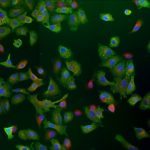Link to Pubmed [PMID] – 19889765
J. Virol. 2010 Jan;84(2):940-52
A deletion of about 20 amino acids in the stalk of the neuraminidase (NA) is frequently detected upon transmission of influenza A viruses from waterfowl to domestic poultry. Using reverse genetics, a recombinant virus derived from a wild duck influenza virus isolate, A/Mallard/Marquenterre/Z237/83 (MZ), and an NA stalk deletion variant (MZ-delNA) were produced. Compared to the wild type, the MZ-delNA virus showed a moderate growth advantage on avian cultured cells. In 4-week-old chickens inoculated intratracheally with the MZ-delNA virus, viral replication in the lungs, liver, and kidneys was enhanced and interstitial pneumonia lesions were more severe than with the wild-type virus. The MZ-delNA-inoculated chickens showed significantly increased levels of mRNAs encoding interleukin-6 (IL-6), transforming growth factor-beta4 (TGF-beta4), and CCL5 in the lungs and a higher frequency of apoptotic cells in the liver than did their MZ-inoculated counterparts. Molecular mechanisms possibly underlying the growth advantage of the MZ-delNA virus were explored. The measured enzymatic activities toward a small substrate were similar for the wild-type and deleted NA, but the MZ-delNA virus eluted from chicken erythrocytes at reduced rates. Pseudoviral particles expressing the MZ hemagglutinin in combination with the MZ-NA or MZ-delNA protein were produced from avian cultured cells with similar efficiencies, suggesting that the deletion in the NA stalk does not enhance the release of progeny virions and probably affects an earlier step of the viral cycle. Overall, our data indicate that a shortened NA stalk is a strong determinant of adaptation and virulence of waterfowl influenza viruses in chickens.

